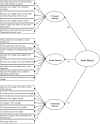Assessing the quality of life of health-referred children and adolescents with short stature: development and psychometric testing of the QoLISSY instrument
- PMID: 23648112
- PMCID: PMC3666886
- DOI: 10.1186/1477-7525-11-76
Assessing the quality of life of health-referred children and adolescents with short stature: development and psychometric testing of the QoLISSY instrument
Abstract
Background: When evaluating the outcomes of treatment in paediatric endocrinology, the health-related quality of life (HrQoL) of the child is to be taken into consideration. Since few self-reported HrQoL instruments exist for children with diagnosed short stature (dSS), the objective of this study was to develop and psychometrically test a targeted HrQoL instrument for use in multinational clinical research.
Methods: The target population were short stature (height<-2 SDS) children and adolescents (age 8-12 and 13-18 years) with a diagnosis of growth hormone deficiency (GHD) or idiopathic short stature (ISS), differing in growth hormone treatment status. Focus group discussions for concept and item generation, piloting of the questionnaire with cognitive debriefing, and instrument field testing with a retest were conducted simultaneously in five countries. After qualitative and preliminary quantitative analyses, psychometric testing of field test data in terms of reliability and validity including confirmatory factor analyses (CFA) was performed.
Results: Following item generation from focus group discussions, 124 items were included in a pilot test with a cognitive debriefing exercise providing preliminary feedback on item and domain operating characteristics. A field test with 268 participants showed high internal consistency reliabilities (alpha 0.82-0.95), good correlations with generic measures (up to r=.58), significant known group differences (e.g. in height: F=32, df 244, p<0.001) and an acceptable CFA model fit suggesting construct validity of the three-domain core structure with 22 items, supplemented by three mediator domains with 28 items.
Conclusions: The QoLISSY questionnaire is a promising step forward in assessing the impact of dSS on HrQoL. It is based on items generated from the subjective experience of short stature children referred for endocrine investigation, is validated for use in five languages and it is easy to administer in clinical and research settings.
Figures
Similar articles
-
Parental perception of health-related quality of life in children and adolescents with short stature: literature review and introduction of the parent-reported QoLISSY instrument.Pediatr Endocrinol Rev. 2013 Dec;11(2):147-60. Pediatr Endocrinol Rev. 2013. PMID: 24575550 Review.
-
Evaluation of the American-English Quality of Life in Short Stature Youth (QoLISSY) questionnaire in the United States.Health Qual Life Outcomes. 2015 Apr 2;13:43. doi: 10.1186/s12955-015-0236-2. Health Qual Life Outcomes. 2015. PMID: 25889818 Free PMC article.
-
Validation of the Flemish version of the Quality of Life in Short Stature Youth (QoLISSY) questionnaire.Acta Clin Belg. 2014 Jun;69(3):177-82. doi: 10.1179/2295333714Y.0000000024. Epub 2014 Apr 2. Acta Clin Belg. 2014. PMID: 24694268
-
Validation of the Italian Quality of Life in Short Stature Youth (QoLISSY) questionnaire.J Endocrinol Invest. 2017 Oct;40(10):1077-1084. doi: 10.1007/s40618-017-0667-1. Epub 2017 Apr 10. J Endocrinol Invest. 2017. PMID: 28397185
-
Development and Validation of a Health-Related Quality-of-Life Measure in Older Children and Adolescents with Early-Onset Scoliosis: Early-Onset Scoliosis Self-Report Questionnaire (EOSQ-SELF).J Bone Joint Surg Am. 2022 Aug 3;104(15):1393-1405. doi: 10.2106/JBJS.21.01508. Epub 2022 Jun 20. J Bone Joint Surg Am. 2022. PMID: 35726883 Review.
Cited by
-
Perceptions of the General Public About Health-related Quality of Life and the EQ-5D Questionnaire: A Qualitative Study in Korea.J Prev Med Public Health. 2022 May;55(3):213-225. doi: 10.3961/jpmph.22.151. Epub 2022 May 31. J Prev Med Public Health. 2022. PMID: 35677995 Free PMC article.
-
Dental Abnormalities in Pituitary Dwarfism: A Case Report and Review of the Literature.Case Rep Dent. 2017;2017:5849173. doi: 10.1155/2017/5849173. Epub 2017 Mar 28. Case Rep Dent. 2017. PMID: 28458931 Free PMC article.
-
Lifetime impact of achondroplasia study in Europe (LIAISE): findings from a multinational observational study.Orphanet J Rare Dis. 2023 Mar 15;18(1):56. doi: 10.1186/s13023-023-02652-2. Orphanet J Rare Dis. 2023. PMID: 36922864 Free PMC article.
-
Psychometric properties of the quality of life in short statured youth (QoLISSY) questionnaire within the course of growth hormone treatment.Health Qual Life Outcomes. 2019 Mar 18;17(1):49. doi: 10.1186/s12955-019-1118-9. Health Qual Life Outcomes. 2019. PMID: 30885197 Free PMC article.
-
Quality of life and profile of mood states in patients with childhood-onset hypopituitarism and growth hormone deficiency during the discontinuation of growth hormone replacement therapy at the transition from adolescence to adulthood.Endocrine. 2025 Mar;87(3):1182-1193. doi: 10.1007/s12020-024-04111-9. Epub 2024 Nov 26. Endocrine. 2025. PMID: 39586904
References
-
- Bullinger M, Schmidt S, Petersen C, Erhart M, Ravens-Sieberer U. Methodological challenges and potentials of health-related quality of life evaluation in children with chronic health conditions under medical health care [in German] Med Klin. 2007;102:734–745. doi: 10.1007/s00063-007-1092-6. - DOI - PubMed
-
- Chaplin J, Kriström B, Dahlgren J, Albertsson-Wikland K. In: The Somatotrophic Axis in Brain Function, Science & Technology Chapter 19. Neyberg F, editor. St. Louis: Life Sciences F. Elsevier; 2006. Psychological importance to the child of growth hormone replacement; pp. 249–266.
Publication types
MeSH terms
Supplementary concepts
LinkOut - more resources
Full Text Sources
Other Literature Sources
Miscellaneous




